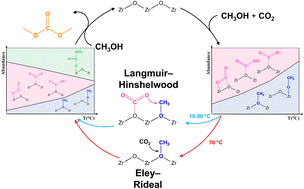Surface species in direct liquid phase synthesis of dimethyl carbonate from methanol and CO2: an MCR-ALS augmented ATR-IR study†
Abstract
The reaction mechanism of dimethyl carbonate (DMC) production over ZrO2 from CO2 and CH3OH is well-known, but the level of understanding has not improved in the last decade. Most commonly, the reaction mechanism has been explored in the gas phase, whilst DMC production occurs in the liquid phase. To overcome this contradiction, we exploited in situ ATR-IR spectroscopy to study DMC formation over ZrO2 in the liquid phase. A multiple curve resolution-alternate least square (MCR-ALS) approach was applied to spectra collected during the CO2/CH3OH interaction with the catalyst surface, leading to the identification of five pure components with their respective concentration profiles. CO2 and CH3OH activation to carbonates and methoxide species was found to strongly depend on the reaction temperature. Low temperature prevents methanol dissociation leaving a catalyst covered with stable carbonates, whilst higher temperature decreases the stability of the carbonates and enhances the formation of methoxides. A reaction path involving the methoxide/carbonate interaction at the surface was observed at low temperature (≤50 °C). We propose that a different reaction path, independent of carbonate formation and involving the direct CO2/methoxide interplay, occurs at 70 °C.

- This article is part of the themed collection: 2023 PCCP HOT Articles


 Please wait while we load your content...
Please wait while we load your content...